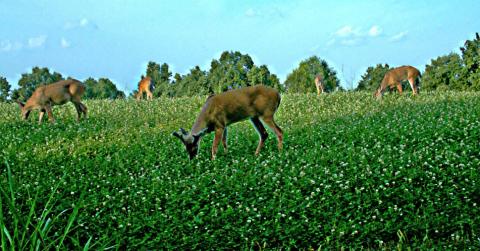Ron Jolly | Originally published in GameKeepers: Farming for Wildlife Magazine. To subscribe, click here.
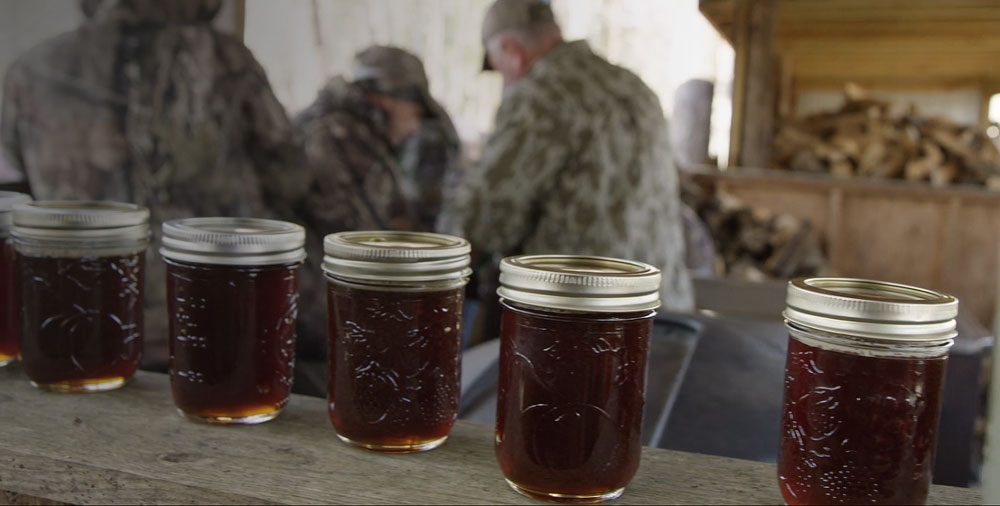
The sweet, sticky goodness that we pour over our pancakes has been used in some form for centuries. Native Americans took out moisture from the sap by freezing it and removing the ice or reducing it by boiling over cooking stones. Now, sap is boiled down over wood-burning or more modern heating oil stoves. Watch the process on the short film “Sap Brothers” on Mossy Oak GO.
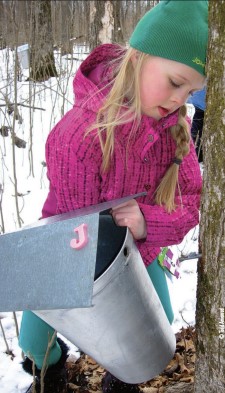
Catskill Mountain Sugar House
use hoses to run the sap to a
central location or right to the
cooking house. Others choose to
make collecting sap a family
affair. The magnet on the
protective cover is moved once
the sap is collected so you can
see at a distance which taps are
already done.
No one knows for sure when the sap from maple trees was first rendered into syrup. It is known that American Indians in the Great Lakes area were already producing syrup when the first Europeans arrived in America. The Indians used stone tools to carve V-shaped grooves in trees to release the sap. Hollow reeds or concave-shaped pieces of bark were used to funnel the sap into buckets often made of birch bark.
Once the sap was gathered the Indians used hot cooking stones to heat the sap. Another practice was to allow the liquid to freeze and remove the layer of ice on top. Both of these methods served to remove excess water from the sap and concentrate the sugar. The end product was a source of nutrition used for trade and in food preparation.
Early settlers soon learned the value of the sweet elixir and began to make their own. They used augers to bore holes in maple trunks. Wooden tubes were fashioned to insert into the holes and buckets were hung on the tubes to collect the sap.
Collected sap was transported to a large iron pot where it was boiled to remove the excess water. The end product was what we know today as maple syrup.
Maple Tree Physiology
To successfully make maple syrup, you must know a few things about the trees that produce the sap. There are several different types of maple trees (genus Acer) that produce desirable sap. Sugar maple, Acer saccharum, is normally the best producer. Red maple, Acer rubrum, also produces sweet sap.
The size of the tree determines the number of tap holes. A tree 10 to 20 inches in diameter receives a single tap while a tree 25 inches or more in diameter can support three taps.
During late summer, maple trees stop growing and begin storing excess starches in the sapwood. Then, during winter, the trees go dormant. As spring approaches and temperatures rise, enzymes found in ray cells convert the starch into sugar. When temperatures reach 45 degrees Fahrenheit, pressure rises in the tree. When a hole is bored into the tree or the bark is cut, vessels in the sapwood are severed allowing sap to flow from the tree.
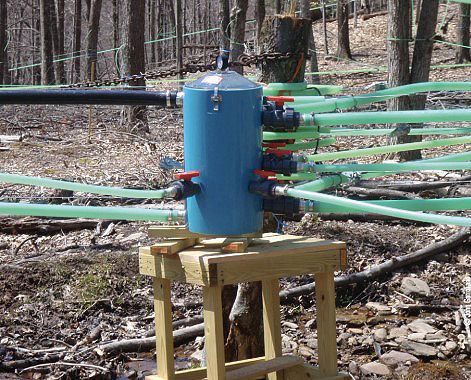
vacuum in the lines combined with gravity help the sap flow freely to
the collection tank.
The amount of sap from a single tap varies greatly depending on ambient temperature, the tree and length of the season.
Some taps can produce 40 gallons of sap or more, but the average is around 10 gallons. The sugar content of the sap varies from tree to tree and grove to grove but averages around two to three percent.
The Old Days
It takes ten gallons of sap to produce one quart of maple syrup. Getting the sap from the tree to the cooking station has always been a challenge. Early settlers developed sleds with large holding barrels to collect the sap. Draft animals were used to pull the sled from collection point to collection point. When the barrel was full it was hauled to the cooking station. Large iron kettles were heated by wood fires to boil down the sap. The kettles were not efficient and the amount of firewood needed was exorbitant. Rendered sap was stored in wooden barrels for consumption.
This process was very time consuming and physically demanding. In the mid-1800s, flat sheet metal pans were developed to boil the sap. These pans provided more surface area and were more efficient. In 1852, the first evaporator was patented. Wooden barrels were replaced with metal containers used to transport the sap and finished syrup.

by updating his evaporator to a model that uses
fuel oil.
In the early 1900s, draft animals used to haul sleds were replaced with tractors. Wooden storage barrels were replaced by metal containers. Eventually, metal lines were developed to transport the sap from the tree to a central collection point. This practice was not widely used because of the expense of the metal tubes. It would be in the 1970s before the industry developed many of the modern techniques used today.
Today
Technology improvements have made producers of maple syrup much more efficient. The age-old problem of getting raw sap to a central location for rendering was solved with the advent of plastic lines and vacuum pumps. Boiling time has been greatly reduced by the use of heating oil for fuel and more efficient evaporators. Advancements in the filtering process and storage in stainless steel barrels allow the syrup to be stored, reheated and bottled to order.
John Garigliano, of Grahamsville, New York, operates the “Catskill Mountain Sugar House” where they produce maple syrup, sugar and candy. In 2011 I traveled to Grahamsville to hunt turkeys in May. The sugar season was over, but evidence of the maple operation and the work that went into it were everywhere. I first met Walter Garigliano, John’s father, over 25 years ago and have watched his five sons grow into young adults. Over the course of a week, I tried to learn all I could about the operation.
“I graduated Auburn University in the spring of 2009 with a degree in Agri-business. I came back to New York to manage our family land,” said John. “Maple syrup production was just a natural. Older brother Jim and I worked seasonally for maple sugar operations when we were growing up. We had lots of maple trees on the property, so it was only natural that we utilize them.”
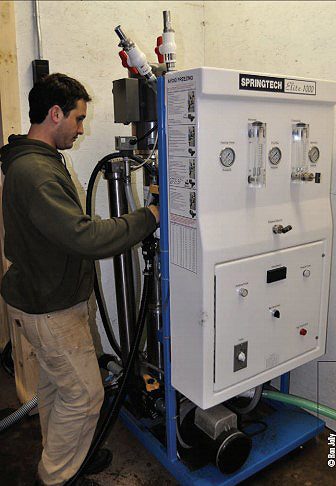
90% of the water from the sap and can process
up to 2,500 gallons of sap per hour.
I had hunted the Garigliano property several times in previous years, so I was familiar with the land. What I was not prepared for were the changes to the landscape to accommodate the sap harvest.
“Our first goal was to design and build the sugar house. Jim’s company, Garigliano Construction, broke ground in September of 2008 and completed the sugar house in early 2009. Outside air vents were built into the concrete floor and a series of hand-operated, pulley-driven louvers mounted in the roof could be adjusted to take advantage of wind direction and efficiently remove steam generated during sap boiling.”
“We had to identify areas where maple trees existed in sufficient numbers to justify the effort,” said John. “Once an area was deemed suitable, we began with a select timber thinning. The tubing that brings the sap to the collection site lasts 20 years, so timber harvest before line installation was essential. This removed competing tree species and created space for the maple trees. Thinning gave the maples more sunlight and room to grow. It also made running lines easier and removed some of the risk of falling limbs or trees tearing down established lines.”
“The thinning also benefitted our wildlife, especially our deer. We have a short growing season here, but by the second season, there was a significant increase in browse and cover. The whitetails really take advantage of these areas. I also believe it has helped provide nesting cover for turkeys.”
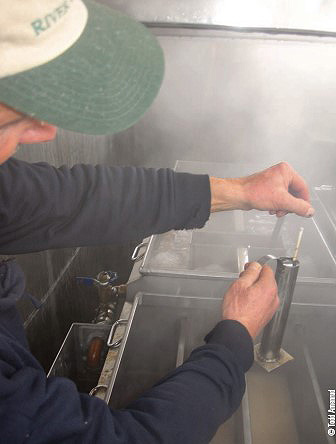
content of the sap. Sugar content from the sap
straight from the tree is about two to three percent.
“The first year, we only had 500 taps. We continued locating good areas, thinning competitive trees, and establishing main lines. In 2010, I hired three men to help with tapping trees. That was a mild winter, and we did not have a lot of snow. In February, at the first hint of thaw, the four of us started tapping trees. We worked seven days a week. We use battery powered drills to make the tap hole. We insert ¼ inch taps in the holes and run 5/16 inch line from the tap to the connecting 1-inch lines that run to the main 2-inch line. We had 20,000 taps that season, collected 320,000 gallons of sap and produced 4,500 gallons of finished syrup.”
“Some of the sap lines run directly to the sugar house. We have another three collection stations scattered across the property. We installed a vacuum pump at each collection site. The vacuum in the lines and gravity help the sap flow freely to the collection tank. It also tricks the tree into believing the atmospheric pressure outside the tree is greater than the pressure inside the tree stimulating more sap flow. We bought a retired milk tanker to transport sap from those collection tanks to the sugar house.”
“Our first evaporator was not a great one. It was slow and required wood for fuel. I can’t tell you how much work went into cutting enough wood to keep that thing running.”
“In 2011, we updated our evaporator to a model that uses fuel oil, and our efficiency really improved. We also added a reverse osmosis machine. That machine separates up to 90% of the water from the sap and can process up to 2500 gallons of sap per hour. This process reduces boiling time dramatically. The new evaporator can process 450 gallons of sap per hour and yield 70 gallons of finished maple syrup per hour.”
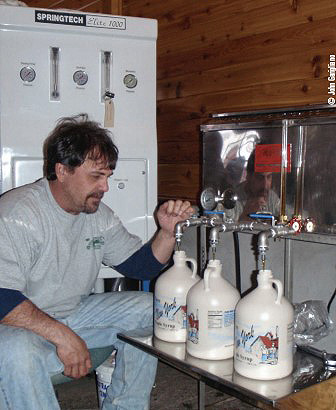
sugarhouse, packaged and delivered fresh.
“The finished syrup is stored in steel barrels to be reheated and bottled to order. Usually, we average around 25 gallons of sap per tap. In 2011, we averaged 16 gallons per tap. Our last day to boil sap and produce syrup was March 17.”
After the Season
When sap season ends, the work is not over. John and his crew head back to the woods and remove every tap. This begins the healing process for the tree which takes about two years. Once all the taps are removed the lines are then flushed from the bottom up with a mixture of water and air. This is to clean the lines and remove sap residue and eliminate bacteria. When the lines have been flushed, each tap is closed thus sealing the line and preventing contamination.
The next spring at the first hint of thaw, John and his crew drill new tap holes in trees already in production and place new taps in those trees. Trees that will be in production for the first time are tapped and connected to new lines that deliver the sap to the collection station.
Orders are filled as they arrive. The stored syrup is heated and bottled for delivery. Some syrup is boiled to 250 degrees Fahrenheit then poured into molds where it cools into maple candy. Maple butter and maple sugar are made as well. All products are made at the sugar house, then packaged and delivered fresh.
For the Garigliano’s it’s all about family, the land and the trees. It is about wisely taking advantage of the renewable resources available to them. It is about fresh, taste and quality. The turkey hunting ain’t bad either!

Need wild game meat for a recipe you've been wanting to try? Check out GameKeeper Butchery. GameKeeper Butchery is dedicated to procuring the finest assortment and highest quality of specialty meats from the United States and around the world. Our commitment is to deliver the safest, freshest and most wholesome products.
















